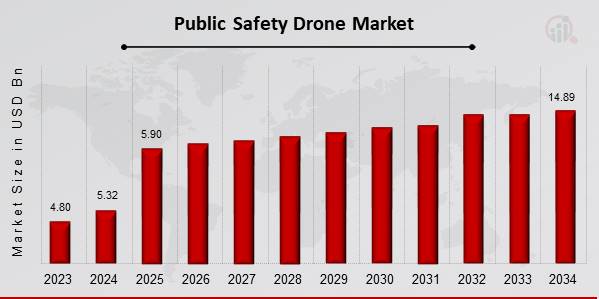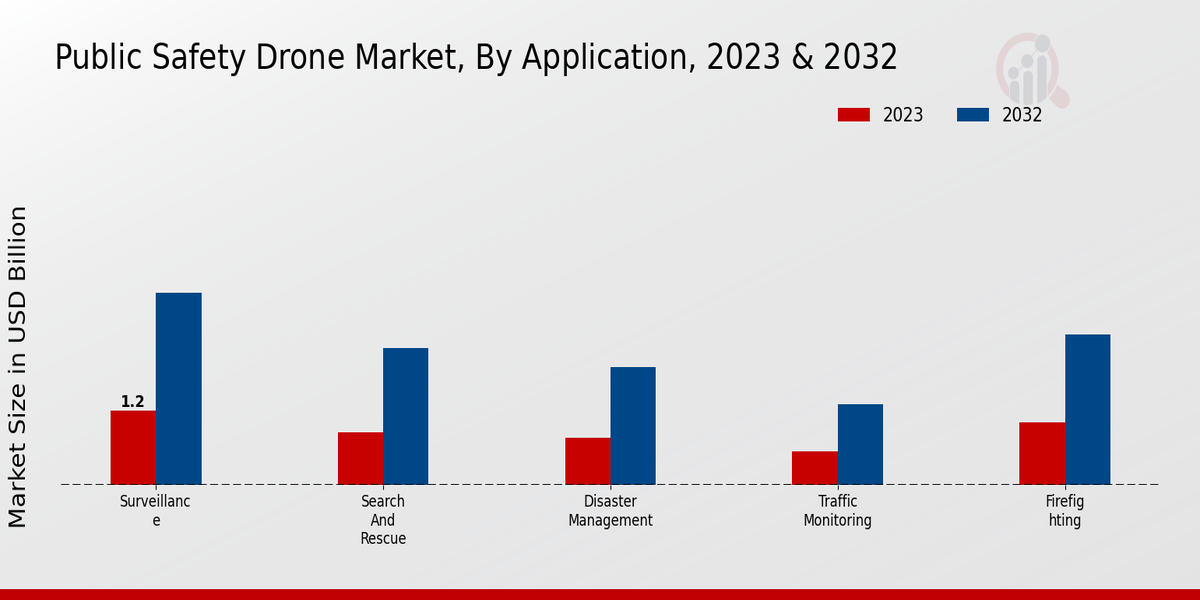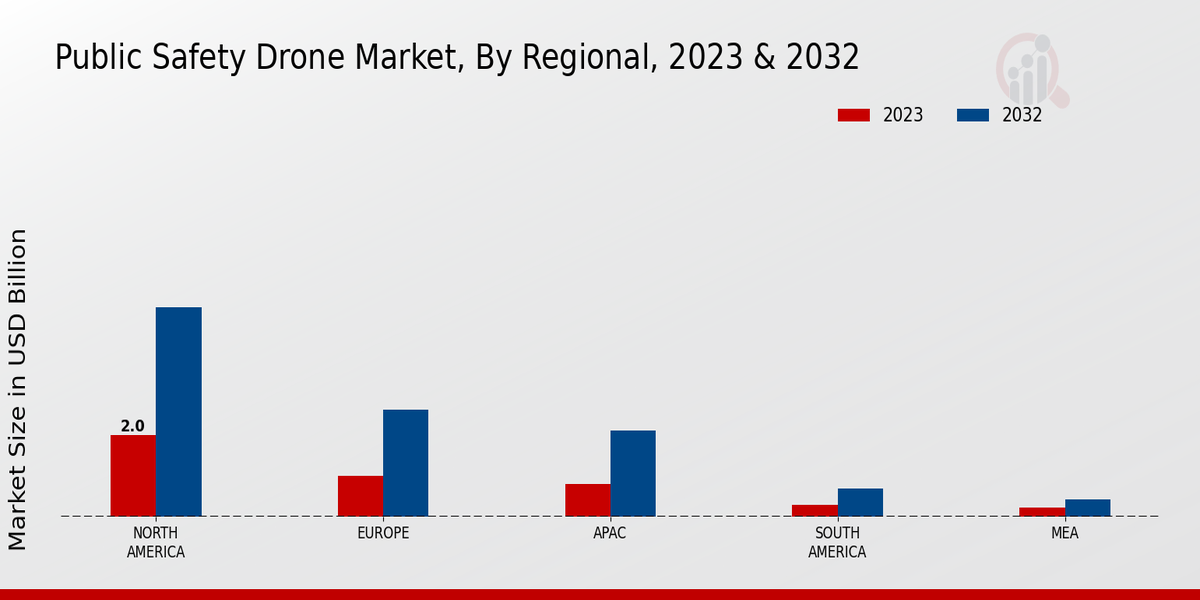Public Safety Drone Market Overview
Public Safety Drone Market Size was estimated at 5.32 (USD Billion) in 2024. The Public Safety Drone Market is expected to grow from 5.9 (USD Billion) in 2025 to 14.89 (USD Billion) by 2034. The Public Safety Drone Market CAGR (growth rate) is expected to be around 10.80% during the forecast period (2025 - 2034).

Source Primary Research, Secondary Research, Market Research Future Database and Analyst Review
Key Public Safety Drone Market Trends Highlighted
The Public Safety Drone Market is experiencing significant momentum due to several key market drivers. An increasing demand for efficient surveillance and monitoring systems has propelled the adoption of drones in public safety operations.
Governments and law enforcement agencies are recognizing the benefits of using drones for tasks like search and rescue missions, traffic monitoring, and emergency response, which enhances overall safety and operational effectiveness.
Technological advancements in drone capabilities, including improved imaging systems, longer flight times, and greater automation, have made these tools more attractive to public safety organizations.
The evolving nature of threats, such as natural disasters and urban crime, presents numerous opportunities for expansion within the market. Public safety agencies can leverage drones for real-time data gathering, which aids in rapid decision-making during emergencies.
Additionally, integration with artificial intelligence and machine learning can enhance the analytical capabilities of drones, providing critical insights for law enforcement and emergency responders.
The growing emphasis on community safety and disaster preparedness further drives interest in deploying drones as a vital component of public safety strategies. Recent trends indicate a surge in collaboration among technology providers and public safety organizations.
This partnership approach has led to innovative solutions tailored to specific community needs. Moreover, the regulatory landscape is gradually becoming more accommodating, allowing for expanded drone operations in urban settings.
As public perception continues to shift positively toward drone usage, the potential for growth in the Public Safety Drone Market continues to increase.
Enhanced training programs and improved operational protocols are also on the rise, laying the groundwork for standardized practices that can streamline drone deployment in various public safety scenarios. This environment of collaboration, innovation, and regulatory support positions the market well for future advancements.
Public Safety Drone Market Drivers
Increased Demand for Efficient Emergency Response Solutions
The Public Safety Drone Market is experiencing a significant surge in demand for efficient emergency response solutions. As public safety agencies are increasingly tasked with addressing emergencies effectively and swiftly, the utilization of drones has proven to be a game-changer.
Drones equipped with high-resolution cameras and real-time data transmission capabilities enable first responders to assess situations more accurately and coordinate responses in real time.
This technological advancement allows for rapid situational awareness, significantly enhancing decision-making processes during critical incidents, such as natural disasters, search and rescue missions, and public safety threats.
Moreover, drones can cover large areas faster than ground forces and can access hard-to-reach or hazardous locations, thereby increasing the likelihood of rescuing victims or preventing further damage.
As the market continues to mature, the integration of advanced technologies, such as artificial intelligence and machine learning algorithms, into drone operations is further optimizing capabilities and effectiveness.
The expected growth in the demand for aerial surveillance and reconnaissance, along with the requirement for rapid aerial support, is expected to propel the Public Safety Drone Market to new heights.
The increasing need for enhanced inspection and monitoring of public events also adds to the rise of drone utilization, as they provide unobstructed and real-time footage of crowd management during large gatherings or public demonstrations.
With the advent of technological integration into drone functionalities, the future prospects for efficient emergency response capabilities through drones are immense.
Technological Advancements in Drone Capabilities
Technological advancements in drone capabilities are playing a pivotal role in driving the Public Safety Drone Market forward. Innovations in drone design, such as enhanced battery life, improved payload capacities, and advanced sensor technology, enable these aerial vehicles to perform a wider array of tasks effectively.
Enhanced imaging technology, including thermal and night vision cameras, allows law enforcement and emergency response teams to conduct surveillance and missions under challenging environmental conditions.
Further advancements in autonomous flight capabilities mean that drones can now perform pre-programmed routines, conduct inspections, and gather data without direct human intervention, greatly improving operational efficiency.
Such advancements not only increase the functionality and versatility of drones but also expand their application across various public safety domains, including law enforcement, disaster management, and environmental monitoring.
Growing Investment in Smart City Initiatives
Growing investment in smart city initiatives is another key driver contributing to the expansion of the Public Safety Drone Market. As cities around the world strive to integrate advanced technologies to improve infrastructure and public services, the adoption of drones becomes essential for ensuring public safety.
Drones play a critical role in monitoring urban environments, managing traffic, and enhancing communication networks. Their deployment in smart city frameworks boosts public safety by providing real-time data analytics that assists city planners and law enforcement agencies in making informed decisions.As urban areas continue to grow and evolve, the integration of drones into smart city infrastructures is set to enhance overall public safety management.
Public Safety Drone Market Segment Insights
Public Safety Drone Market Application Insights
The Public Safety Drone Market holds considerable significance in enhancing operational efficiencies across various domains focused on public safety. The segment encapsulates critical functions such as Surveillance, Search and Rescue, Disaster Management, Traffic Monitoring, and Firefighting, each contributing uniquely to the overall market dynamics.
Surveillance led the charge with a valuation of 1.2 USD Billion in 2023, reflecting its pivotal role in crime prevention, monitoring, and ensuring community safety.
Search and Rescue stood at 0.85 USD Billion in 2023, showcasing its importance in emergency response scenarios where time is crucial for saving lives. Disaster Management, valued at 0.75 USD Billion, emphasizes efficient coordination during natural disasters, ensuring safety and timely response mechanisms.
Traffic Monitoring, although a smaller segment at 0.53 USD Billion, is gaining traction in urban areas as it helps manage congestion and enhances road safety. Firefighting, valued at 1.0 USD Billion, holds significant importance, with drones actively aiding firefighting efforts in hard-to-reach areas, improving response times, and increasing safety for first responders.
Collectively, these segments form an integral part of the Public Safety Drone Market revenue, driving innovations in technology and operational strategies while shaping the future of public safety initiatives.
The landscape of the Public Safety Drone Market segmentation indicates a growing reliance on these aerial solutions to address contemporary challenges in law enforcement, disaster preparedness, and public health response, laying a foundation for robust market growth through 2032, backed by advances in drone technology and increasing adoption for various applications in public safety.
Source Primary Research, Secondary Research, Market Research Future Database and Analyst Review
Public Safety Drone Market End Use Insights
The market comprises critical sectors such as Government, Law Enforcement, Fire Departments, Emergency Medical Services, and Military, which play a crucial role in enhancing operational efficiency and response capabilities. Law Enforcement has become increasingly dependent on drones for surveillance, crowd management, and investigation, which continues to boost demand in this area.
Fire Departments leverage drone technology for real-time aerial assessments during emergencies, thereby improving their response effectiveness. Emergency Medical Services benefit from drones for rapid transportation of medical supplies and patient monitoring, representing a growing segment within the public safety sector.
Meanwhile, the Military sector remains a dominant player, utilizing drones for reconnaissance and tactical advantages in various operations. The increasing integration of advanced technologies in these end-use applications is driving the Public Safety Drone Market growth, while challenges such as regulatory compliance and privacy concerns must be addressed to fully realize market potential.
Public Safety Drone Market Drone Type Insights
The market encompasses various drone types that cater to public safety operations. Key drone types include Fixed Wing, Multi-Rotor, Hybrid, Single Rotor, and Nano. Fixed Wing drones are valued for their long flight times and ability to cover extensive areas, making them ideal for search and rescue missions.
Multi-Rotor drones dominate in surveillance applications due to their agility and ease of deployment in urban environments. The Hybrid drones combine the strengths of both fixed-wing and multi-rotor designs, offering versatility for various applications in public safety.
Single Rotor drones provide high endurance and are commonly used for heavy payload scenarios, while Nano drones are instrumental for tactical operations in confined spaces, allowing for discreet surveillance.
With projected market growth characterized by evolving technology, the public safety domain is increasingly adopting these drones to enhance operational efficiency and response times. The collective advancements contribute significantly to the Public Safety Drone Market data, revealing the growing interest and reliance on these technologies in the industry.
Public Safety Drone Market Payload Capacity Insights
The payload capacity is critical for various public safety applications, as it influences the types of equipment that can be deployed during operations. Different payload capacities cater to specific mission requirements; for instance, the dominant segment includes drones that carry essential emergency response tools.
With the market continuously evolving, categories like 5 to 10 kg exhibit substantial demand due to their versatile nature, allowing for the transportation of both lightweight surveillance equipment and medical supplies.
The segments for 10 to 20 kg are gaining traction as they enable the delivery of heavier payloads, such as firefighting equipment and heavier imaging systems, which are invaluable during crisis situations. Meanwhile, drones with payload capacities above 20 kg emerging for specialized operations in search and rescue missions, demonstrating significant applications in challenging environments.
Collectively, the Public Safety Drone Market data showcases notable trends where advancements in drone technology are propelling market growth across various payload capacities, addressing unique operational challenges in public safety.
Public Safety Drone Market Regional Insights
The Regional segment of the Public Safety Drone Market market showcases a strong growth trajectory, with North America leading the way, having a market valuation of 2.0 USD Billion in 2023 and projected to reach 5.1 USD Billion by 2032, signifying its dominance with majority holding in the overall market.
Europe followed, showing significant potential with a value of 1.0 USD Billion in 2023, expected to grow to 2.6 USD Billion by 2032, driven by increasing adoption of drones for disaster response and public safety operations. The APAC region, while smaller at 0.8 USD Billion in 2023, with projections to reach 2.1 USD Billion by 2032, indicated a burgeoning interest in drone technology for urban management and surveillance.
South America, valued at 0.3 USD Billion in 2023 and projected to grow to 0.7 USD Billion by 2032, finds its growth tied to improving infrastructure and public safety needs. Lastly, MEA's market, valued at 0.23 USD Billion in 2023 and expected at 0.42 USD Billion by 2032, reveals opportunities for drone applications in security and humanitarian efforts, showcasing a growing awareness of public safety technology.
The evolving landscape of these regions reflects the diverse opportunities and unique challenges within the Public Safety Drone Market statistics.
Source Primary Research, Secondary Research, Market Research Future Database and Analyst Review
Public Safety Drone Market Key Players and Competitive Insights
The Public Safety Drone Market has witnessed significant advancements in recent years, driven by the increasing demand for enhanced surveillance, search and rescue operations, disaster management, and law enforcement applications.
As public safety organizations recognize the efficiency and effectiveness that drones can bring to their operations, several key players have emerged, each contributing unique technological innovations and operational capabilities.
This sector comprises a competitive landscape characterized by continuous innovation, market entry by new players, collaborative partnerships, and varying regional adoption rates.
The inclination towards more automated and data-driven methods of addressing public safety challenges amplifies the competition, with companies striving to establish their products as the preferred choice among various governmental and non-governmental entities.
DJI has established a formidable presence in the Public Safety Drone Market by leveraging its advanced technological features and reliability.
Known for its cutting-edge imaging technologies and robust flight capabilities, DJI drones are widely adopted for various public safety applications, such as search and rescue missions, infrastructure inspections, and emergency response scenarios.
The company's substantial investment in research and development has facilitated the introduction of user-friendly interfaces and sophisticated data-gathering tools, empowering public safety officials to make informed decisions swiftly.
With a strong distribution network and a reputation for quality, DJI has effectively positioned itself as a leader in this market, achieving substantial market share due to its ability to cater to diverse operational needs from urban law enforcement to rural emergency services.
Insitu, particularly recognized for its unmanned aerial systems, plays a critical role in the Public Safety Drone Market by offering tailored solutions designed for gathering intelligence in various scenarios.
The company specializes in high-end drones capable of long-range operations, making it an ideal choice for persistent surveillance and reconnaissance tasks. Insitu's products are noted for their rugged design, allowing them to operate in adverse conditions, which is a significant advantage for public safety applications that often face unpredictable environments.
The integration of advanced sensor technologies and real-time data transmission capability further enhances the operational effectiveness of Insitu drones, enabling law enforcement and emergency responders to quickly assess situations and respond accordingly.
The company’s strong focus on collaboration with government agencies ensures that its drones meet specific regulatory requirements, establishing Insitu as a trusted partner in the public safety sector.
Key Companies in the Public Safety Drone Market Include
Public Safety Drone Market Developments
In recent developments within the Public Safety Drone Market, companies like DJI and AeroVironment are pushing the boundaries of drone technology to enhance surveillance and emergency response capabilities.
Insitu has been focusing on integrating advanced analytics into its UAV systems, while Textron continues to expand its drone portfolio for military and civil applications.
Lockheed Martin has been investing in partnerships to develop drone solutions tailored to public safety needs. Additionally, Draganfly and FLIR Systems are leveraging innovations in thermal imaging and drone design to support firefighting and search-and-rescue operations.
Quantum Systems is gaining traction with its efficient UAV platforms, catering to law enforcement and emergency management agencies. In terms of market activity, notable mergers and acquisitions have not been highlighted recently among these key players, suggesting a period of organic growth and collaboration in the sector.
The increasing demand for drones equipped with AI and sensor technologies is driving the market valuation upwards, contributing to greater investment and focus on solutions aimed at enhancing public safety and emergency response efficacy.
Public Safety Drone Market Segmentation Insights
Public Safety Drone Market Application Outlook
Public Safety Drone Market End Use Outlook
- Emergency Medical Services
Public Safety Drone Market Drone Type Outlook
Public Safety Drone Market Payload Capacity Outlook
Public Safety Drone Market Regional Outlook
Public Safety Drone Market Report Scope
| Report Attribute/Metric |
Details |
| Market Size 2024 |
5.32(USD Billion) |
| Market Size 2025 |
5.9(USD Billion) |
| Market Size 2034 |
14.89(USD Billion) |
| Compound Annual Growth Rate (CAGR) |
10.80% (2025 - 2034) |
| Report Coverage |
Revenue Forecast, Competitive Landscape, Growth Factors, and Trends |
| Base Year |
2024 |
| Market Forecast Period |
2025 - 2034 |
| Historical Data |
2021 - 2024 |
| Market Forecast Units |
USD Billion |
| Key Companies Profiled |
DJI, Insitu, Textron, Lockheed Martin, Skyfish, Quantum Systems, Vantage Robotics, Draganfly, AeroVironment, Kespry, Parrot, senseFly, Elbit Systems, Northrop Grumman, FLIR Systems |
| Segments Covered |
Application, End Use, Drone Type, Payload Capacity, Regional |
| Key Market Opportunities |
Increased demand for surveillance applications, Growth in disaster response services, Integration with AI technologies, Expansion of urban air mobility, and Development of regulatory frameworks |
| Key Market Dynamics |
Technological advancements in drones, Increasing demand for surveillance, Government regulations and policies, Rising public safety concerns, and Adoption by emergency services |
| Countries Covered |
North America, Europe, APAC, South America, MEA |
Frequently Asked Questions (FAQ):
The Public Safety Drone Market is expected to be valued at 14.89 USD Billion by 2034.
The projected CAGR for the Public Safety Drone Market from 2025 to 2034 is 10.80%.
North America holds the largest market share, valued at 5.1 USD Billion by 2034.
The Surveillance segment is expected to be valued at 3.1 USD Billion in 2034.
The Search and Rescue applications market is projected to reach 2.2 USD Billion by 2034.
Major players include DJI, Lockheed Martin, Textron, and Elbit Systems among others.
The market size for Disaster Management applications is expected to be 1.9 USD Billion by 2034.
Traffic Monitoring is expected to grow to a market value of 1.3 USD Billion by 2034.
The Firefighting applications market is anticipated to be valued at 2.42 USD Billion by 2034.
The APAC region is expected to reach an overall market value of 2.1 USD Billion by 2034.

















